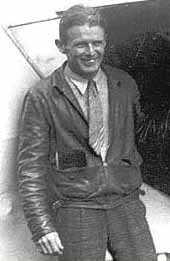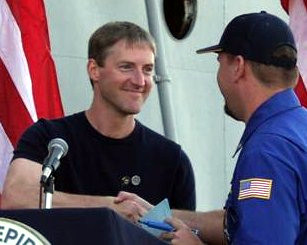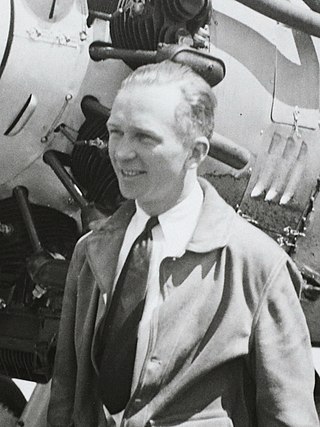Related Research Articles

Charles Augustus Lindbergh was an American aviator and military officer. On May 20–21, 1927, he made the first nonstop flight from New York City to Paris, a distance of 3,600 miles (5,800 km), flying alone for 33.5 hours. His aircraft, the Spirit of St. Louis, was designed and built to compete for the $25,000 Orteig Prize for the first flight between the two cities. Although not the first transatlantic flight, it was the longest at the time by nearly 2,000 miles (3,200 km) and the first solo transatlantic flight. It became known as one of the most consequential flights in history and ushered in a new era of air transportation between parts of the globe.

The Orteig Prize was a reward of $25,000 offered in 1919 by New York City hotel owner Raymond Orteig to the first Allied aviator, or aviators, to fly non-stop from New York City to Paris or vice versa. Several famous aviators made unsuccessful attempts at the New York–Paris flight before the relatively unknown American Charles Lindbergh won the prize in 1927 in his aircraft Spirit of St. Louis.

The Spirit of St. Louis is the custom-built, single-engine, single-seat, high-wing monoplane that Charles Lindbergh flew on May 20–21, 1927, on the first solo nonstop transatlantic flight from Long Island, New York, to Paris, France, for which Lindbergh won the $25,000 Orteig Prize.

John Alcock and Arthur Brown were British aviators who, in 1919, made the first non-stop transatlantic flight. They flew a modified First World War Vickers Vimy bomber from St. John's, Newfoundland, to Clifden, County Galway, Ireland. The Secretary of State for Air, Winston Churchill, presented them with the Daily Mail prize of £10,000 for the first crossing of the Atlantic Ocean by aeroplane in "less than 72 consecutive hours". A small amount of mail was carried on the flight, making it the first transatlantic airmail flight. The two aviators were knighted by King George V at Windsor Castle a week later.

The NC-4 is a Curtiss NC flying boat that was the first aircraft to fly across the Atlantic Ocean, albeit not non-stop. The NC designation was derived from the collaborative efforts of the Navy (N) and Curtiss (C). The NC series flying boats were designed to meet wartime needs, and after the end of World War I they were sent overseas to validate the design concept.
A transatlantic flight is the flight of an aircraft across the Atlantic Ocean from Europe, Africa, South Asia, or the Middle East to North America, Latin America, or vice versa. Such flights have been made by fixed-wing aircraft, airships, balloons and other aircraft.

Douglas Corrigan was an American aviator, nicknamed "Wrong Way" in 1938. After a transcontinental flight in July from Long Beach, California, to New York City, he then flew from Floyd Bennett Field in Brooklyn to Ireland, although his flight plan was filed to return to Long Beach.

Erik Robbins Lindbergh is an American aviator, adventurer, and artist. He is the grandson of pioneering aviator Charles Lindbergh, the first person to fly non-stop and solo between New York and Paris in 1927. In 2002, Erik Lindbergh honored the 75th anniversary of his grandfather's historic flight by retracing the journey in a single-engine Lancair aircraft. The journey was documented by the History Channel, raised over one million dollars for three charities, garnered half a billion media impressions for the X PRIZE Foundation and helped to jump-start the private Spaceflight industry. The flight prompted a call from United States President George W. Bush for inspiring the country after the tragedy of September 11.

Bertrand Blanchard Acosta was a record-setting aviator and test pilot. He and Clarence D. Chamberlin set an endurance record of 51 hours, 11 minutes, and 25 seconds in the air. He later flew in the Spanish Civil War in the Yankee Squadron. He was known as the "bad boy of the air". He received numerous fines and suspensions for flying stunts such as flying under bridges or flying too close to buildings.

The Spirit of St. Louis is a 1957 aviation biography film in CinemaScope and Warnercolor from Warner Bros., directed by Billy Wilder, produced by Leland Hayward, and starring James Stewart as Charles Lindbergh. The screenplay was adapted by Charles Lederer, Wendell Mayes, and Billy Wilder from Lindbergh's 1953 autobiographical account of his historic flight, which won the Pulitzer Prize in 1954.

The Flying Irishman is a 1939 biographical drama film produced by RKO Pictures about Douglas Corrigan's unofficial transatlantic flight the previous year in a dilapidated Curtiss Robin light aircraft. The film was directed by Leigh Jason based on a screenplay by Ernest Pagano and Dalton Trumbo.

Calbraith Perry Rodgers was an American aviation pioneer. He made the first transcontinental airplane flight across the U.S. from September 17, 1911, to November 5, 1911, with dozens of stops, both intentional and accidental. The feat made him a national celebrity, but he was killed in a crash a few months later at an exhibition in California.

Clarence Duncan Chamberlin was an American pioneer of aviation, being the second man to pilot a fixed-wing aircraft across the Atlantic Ocean, from New York to the European mainland, while carrying the first transatlantic passenger.

Giuseppe Mario Bellanca was an Italian-American aviation pioneer, airplane designer and builder, who is credited with many design firsts and whose aircraft broke many aviation records. He was inducted into the National Aviation Hall of Fame in 1973. The Bellanca C.F., one of the world's first enclosed-cabin monoplanes, is on display at the National Air and Space Museum. Bellanca was known mostly for his long range aircraft which led the way for the advancement of international and commercial air transportation.

Charles Albert Levine was the first passenger aboard a transatlantic flight. He was ready to cross the Atlantic to claim the Orteig prize but a court battle over who was going to be in the airplane allowed Charles Lindbergh to leave first.
Moye Wicks Stephens was an American aviator and businessman. He was a pioneer in aviation, circumnavigating the globe with adventure writer Richard Halliburton in 1931, and co-founding Northrop Aircraft, Inc.

L'Oiseau Blanc was a French Levasseur PL.8 biplane that disappeared in 1927 during an attempt to make the first non-stop transatlantic flight between Paris and New York City to compete for the Orteig Prize. French World War I aviation heroes Charles Nungesser and François Coli took off from Paris on 8 May 1927 and were last seen over Ireland. Less than two weeks later, Charles Lindbergh successfully made the New York–Paris journey and claimed the prize in the Spirit of St. Louis.

The Wright-Bellanca WB-2, was a high wing monoplane aircraft designed by Giuseppe Mario Bellanca, initially for Wright Aeronautical then later Columbia Aircraft Corp.

The Levasseur PL.8 was a single engine, two-seat long-distance record-breaking biplane aircraft modified from an existing Levasseur PL.4 carrier-based reconnaissance aircraft produced in France in the 1920s. Levasseur built the aircraft in 1927, specifically for pilots Charles Nungesser and François Coli for a transatlantic attempt to win the Orteig Prize. Only two examples of the type were built, with the first PL.8-01 named L'Oiseau Blanc, that gained fame as Nungesser and Coli's aircraft.

"WE" is an autobiographical account by Charles A. Lindbergh (1902–1974) about his life and the events leading up to and including his May 1927 New York to Paris solo trans-Atlantic flight in the Spirit of St. Louis, a custom-built, single engine, single-seat Ryan monoplane. It was first published on July 27, 1927 by G.P. Putnam's Sons in New York.
References
- ↑ Stanley, J. (2000) Creature Feature: 3rd Edition
- ↑ Disney Channel Magazine, November 1985 issue, Page 3 (archive), Retrieved Oct 7, 2021
- ↑ christophernguyen726 (2019-04-21). "The Blue Yonder: VHS Vs. ABC TV Version". Bootleg Comparisons. Retrieved 2019-04-22.
{{cite web}}: CS1 maint: numeric names: authors list (link) - ↑ Margulies, Lee (February 8, 1986). "FOCUS ON FANTASY AND NIGHTMARES". Los Angeles Times . Retrieved February 8, 2020.